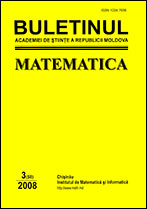|
|
Buletinul Academiei de Ştiinţe a Republicii Moldova. Matematica, 2008, Number 3, Pages 67–75
(Mi basm37)
|
 |
|
 |
Research articles
A numerical approximation of the free-surface heavy inviscid flow past a body
Luminita Grecua, T. Petrilab
a Department of Applied Sciences, Faculty of IMST, University of Craiova, Romania
b Department of Applied Mathematics, Faculty of Mathematics and Computer Science, Babes-Bolyai University of Cluj-Napoca, Romania
Abstract:
The object of this paper is to apply the Complex Variable Boundary Element Method (CVBEM) for solving the problem of the bidimensional heavy fluid flow over an immersed obstacle, of smooth boundary, situated near the free surface in order to obtain the perturbation produced by its presence and the fluid action on it. Using the complex variable, complex perturbation potential, complex perturbation velocity and the Cauchy's formula the problem is reduced to an integro-differential equation with boundary conditions. For solving the integro-differential equation a complex variable boundary elements method with linear elements is developed. We use linear boundary elements for discretize smooth curve, and free surface, in fact we approximate them with polygonal lines formed by segments, and we choose for approximating the unknown on each element a linear model that uses the nodal values of the unknown. Finite difference schemes are used for eliminating the derivatives that appear. The problem is finally reduced to a system of linear equations in terms of nodal values of the components of the velocity field. All coefficients in the mentioned system are analytically calculated. Those arising from singular integrals are evaluated using generalized Cauchy integrals. After solving the system we obtain the velocity and further the local pressure coefficient and the fluid action over the obstacle can be deduced. For evaluating the coefficients and for solving the system to which the problem is reduced, we can use a computer code.
Keywords and phrases:
Boundary integro-differential equation, linear boundary element, boundary element method.
Received: 21.09.2006
Citation:
Luminita Grecu, T. Petrila, “A numerical approximation of the free-surface heavy inviscid flow past a body”, Bul. Acad. Ştiinţe Repub. Mold. Mat., 2008, no. 3, 67–75
Linking options:
https://www.mathnet.ru/eng/basm37 https://www.mathnet.ru/eng/basm/y2008/i3/p67
|

| Statistics & downloads: |
| Abstract page: | 216 | | Full-text PDF : | 65 | | References: | 52 | | First page: | 1 |
|




 Contact us:
Contact us: Terms of Use
Terms of Use
 Registration to the website
Registration to the website Logotypes
Logotypes









 Citation in format
Citation in format 